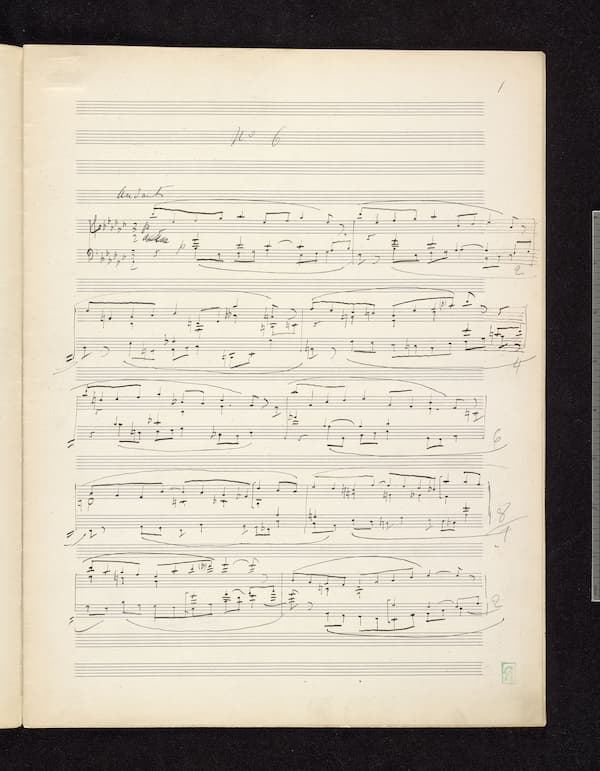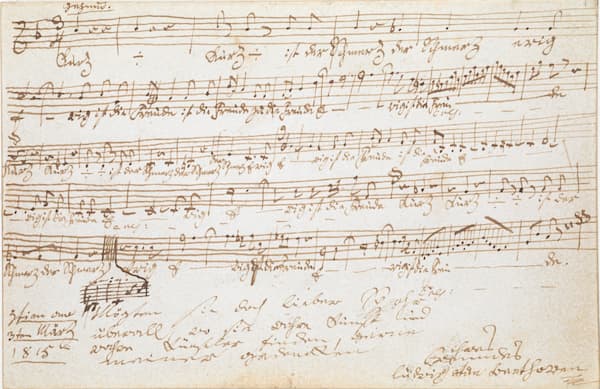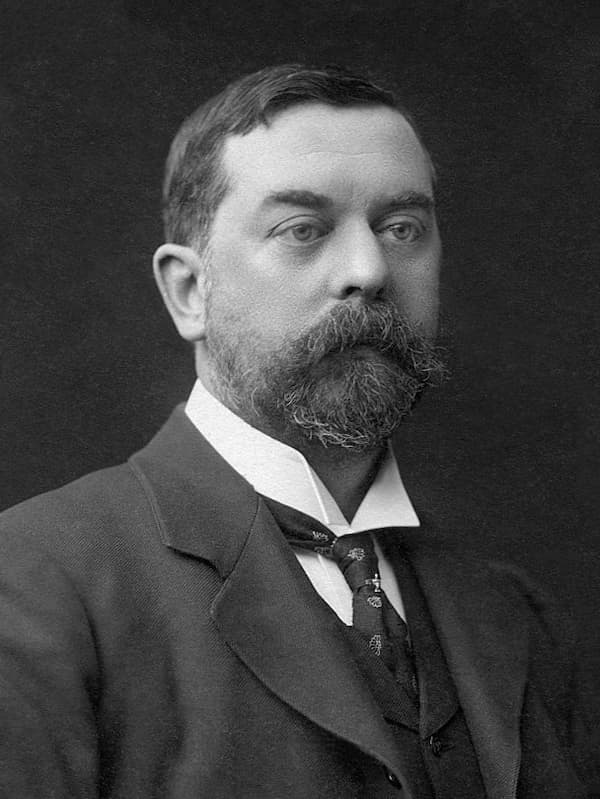This episode of my favorite canons starts with an accidental discovery. In 1975, the Bibliothèque Nationale de France acquired the first edition of the Bach’s Goldberg Variations. It turned out that this particular printed score had originally belonged to Bach himself and that the composer made various interesting annotations in the score. But that particular score also contained a bombshell, as the back cover showed 14 canons written in the form of musical puzzles. What Bach had notated were fourteen canons built on the first eight bass notes of the “Aria” from the Goldberg Variations. Only the canons No. 11 and 13 had been known before 1975, the rest were unknown compositions. Scholars immediately latched on to the total number of canons, and 14 turns out to be a highly significant number. If you assign a number to each letter of the alphabet starting with A=1, then B+A+C+H equals 14. Moreover, J+S+B+A+C+H equals 41, the numerical inversion of 14. In these 14 puzzle-canons inversions reign supreme as Bach sketched a highly personal and symbolic universe.

Johann Sebastian Bach
Johann Sebastian Bach: 14 Canons based on the first Eight Bass Notes of the Preceding Aria (Goldberg Variations), BWV 1087 “Aria” (Masaaki Suzuki, harpsichord)
Each canon is notated like a cryptic puzzle, and the repeating bass notes—sometimes called a ground—are seen and heard throughout all canons. The opening “Canon Simplex” presents this ground bass first played from beginning to end, and then backwards, from the end to the beginning. Then, both versions are played together. In “Canon all’roverscio” Bach turns the ground bass upside down—what we call inversion, and combines it with the version played from back to front, which we call retrograde. In “Motu recto e contrario”, the ground is combined with its inversion, which enters after four notes. Next, in “Motu contrario e recto”, we get the inversion of the ground and its inversion.
Johann Sebastian Bach: 14 Canons based on the first Eight Bass Notes of the Preceding Aria (Goldberg Variations), BWV 1087 “No. 1. Canon simplex” (Masaaki Suzuki, harpsichord)
Johann Sebastian Bach: 14 Canons based on the first Eight Bass Notes of the Preceding Aria (Goldberg Variations), BWV 1087 “No. 2. All’ roverscio” (Masaaki Suzuki, harpsichord)
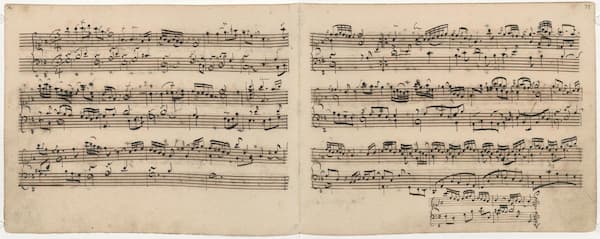
J.S. Bach’s Goldberg Variations “Aria”, autograph copied by Anna Magdalena Bach
By now, we are pretty much tuned into the Goldberg ground, played forward, backwards and in inversion. Now the fun really starts! In “Canon duplex a 4”, we hear the ground and its inversion, but Bach adds another canon on top, which is also heard in inversion. So what you actually hear is the ground plus inversion woven together with the new canon plus inversion. The Goldberg ground now gives rise to a precise mirror canon, with the follower using the same intervals but moving in the opposite direction. This is followed by a second mirror canon, using the inversion of the Goldberg ground. In Canon VIII, Bach moves the Goldberg ground from the bass voice to the alto voice. The canons surround that voice in contrary motion, once again as a precise mirror canon.
Johann Sebastian Bach: 14 Canons based on the first Eight Bass Notes of the Preceding Aria (Goldberg Variations), BWV 1087 “No. 5. Canon duplex a 4” (Masaaki Suzuki, harpsichord)
Johann Sebastian Bach: 14 Canons based on the first Eight Bass Notes of the Preceding Aria (Goldberg Variations), BWV 1087 “No. 6. Canon simplex über besagtes Fundament a 3” (Masaaki Suzuki, harpsichord)
So far, Bach has given us a pretty methodical demonstration of what can be done with 8 bass notes. Ingenious, I hear you say, but better hold on to your hats as Bach now really gets started. In the “Canon in unisono post semifusam a 3 voci” the canon over the ground imitate each other in unison but trail each other by a mere sixteenth note. The next canon, “Alio moda, per syncopationes”, features two lines, each moving against their own inversions. The next “Canon duplex a 5” is full of theological symbolism. Technically, it’s a 5-voice double mirror canon that “condenses into a few bars of musical notation a magnificent artistic achievement with multiple layers of meaning.” A further “Canon duplex a 5 voci” features two canon plus inversions superimposed on the Goldberg ground.
Johann Sebastian Bach: 14 Canons based on the first Eight Bass Notes of the Preceding Aria (Goldberg Variations), BWV 1087 “No. 9. Canon in unisono post semifusam a 3” (Masaaki Suzuki, harpsichord)
Johann Sebastian Bach: 14 Canons based on the first Eight Bass Notes of the Preceding Aria (Goldberg Variations), BWV 1087 “No. 10. Alio modo, per syncopationes et per ligaturas a 2 – Evolutio” (Masaaki Suzuki, harpsichord)
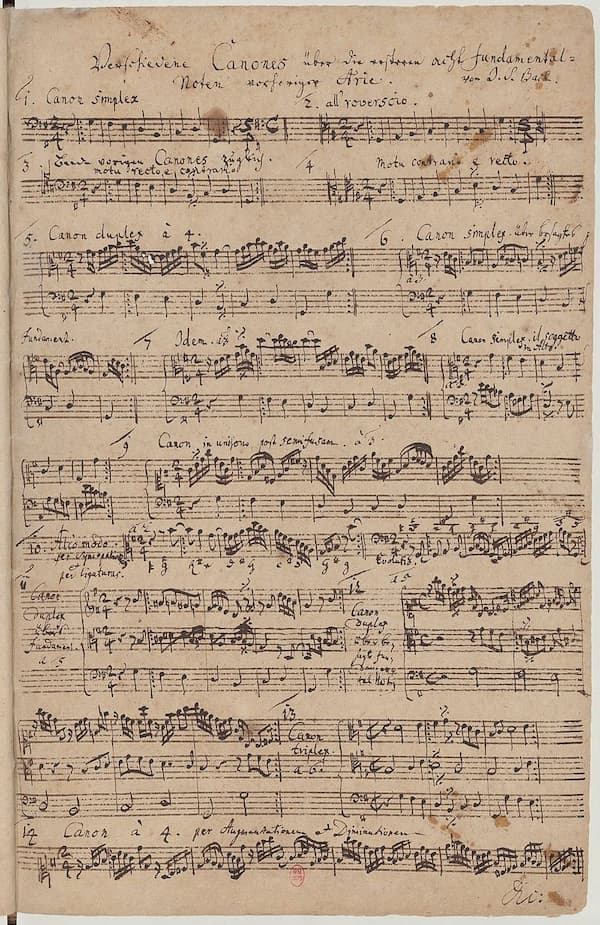
J.S. Bach’s 14 Canons, BWV 1087
A double canon sounds 4 voices, with each canon having a leader and a follower. So when Bach writes a “Canon triplex a 6 voci” we are naturally dealing with 3 canons sounding at the same time. The final “Canon a 4 voice per Augmentationem et Diminutionem” demonstrates not only various canonic procedures but also that the rhythmic values can appear in various multiples of the original. It all sounds rather complicated in theory, but just listen to the effortlessly unfolding music. From a simple canonic procedure, the pieces become rhythmically and texturally ever more active and reach an astonishing climax in Canon 14. Below that final canon, Bach writes “et cetera,” suggesting that there is an infinite number of canons that could be spun out from this simple 8-note bass ground. From the series of canons in the Goldberg Variations and the 14 Canons based on the Goldberg bass, it becomes evident that Bach merges keyboard virtuosity with an ultimate mastery of composition. Together, they represent some of my favorite canons and music puzzles because despite their mind-blowing technical complexity—and you can watch them visually in the excellent YouTube clip–Bach never sacrifices music nor content.
For more of the best in classical music, sign up for our E-Newsletter
Johann Sebastian Bach: 14 Canons based on the first Eight Bass Notes of the Preceding Aria (Goldberg Variations), BWV 1087 “No. 13. Canon triplex a 6” (Masaaki Suzuki, harpsichord)
Johann Sebastian Bach: 14 Canons based on the first Eight Bass Notes of the Preceding Aria (Goldberg Variations), BWV 1087 “No. 14. Canon a 4 per Augmentationem et Diminutionem” (Masaaki Suzuki, harpsichord)

